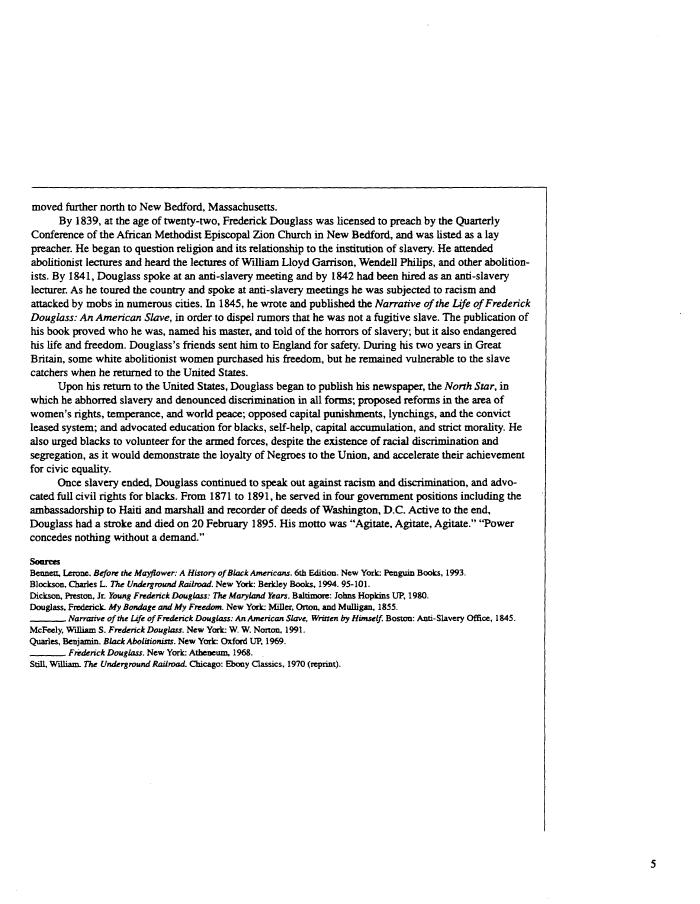 |
||||
|
TASK FORCE TO STUDY THE HISTORY AND LEGACY OF SLAVERY IN MARYLAND (Final Report) 1999/12/31 MdHR 991422 MdHR 991422, Image No: 365 Print image (70K) |
 |
||||
|
TASK FORCE TO STUDY THE HISTORY AND LEGACY OF SLAVERY IN MARYLAND (Final Report) 1999/12/31 MdHR 991422 MdHR 991422, Image No: 365 Print image (70K) |
| moved further north to New Bedford, Massachusetts. By 1839, at the age of twenty-two, Frederick Douglass was licensed to preach by the Quarterly Conference of the African Methodist Episcopal Zion Church in New Bedford, and was listed as a lay preacher. He began to question religion and its relationship to the institution of slavery. He attended abolitionist lectures and heard the lectures of William Lloyd Garrison, Wendell Philips, and other abolitionists. By 1841, Douglass spoke at an anti-slavery meeting and by 1842 had been hired as an anti-slavery lecturer. As he toured the country and spoke at anti-slavery meetings he was subjected to racism and attacked by mobs in numerous cities. In 1845, he wrote and published the Narrative of the Life of Frederick Douglass: An American Slave, in order to dispel rumors that he was not a fugitive slave. The publication of his book proved who he was, named his master, and told of the horrors of slavery; but it also endangered his life and freedom. Douglass's friends sent him to England for safety. During his two years in Great Britain, some white abolitionist women purchased his freedom, but he remained vulnerable to the slave catchers when he returned to the United States. Upon his return to the United States, Douglass began to publish his newspaper, the North Star, in which he abhorred slavery and denounced discrimination in all forms; proposed reforms in the area of women's rights, temperance, and world peace; opposed capital punishments, lynchings, and the convict leased system; and advocated education for blacks, self-help, capital accumulation, and strict morality. He also urged blacks to volunteer for the armed forces, despite the existence of racial discrimination and segregation, as it would demonstrate the loyalty of Negroes to the Union, and accelerate their achievement for civic equality. Once slavery ended, Douglass continued to speak out against racism and discrimination, and advocated full civil rights for blacks. From 1871 to 1891, he served in four government positions including the ambassadorship to Haiti and marshal! and recorder of deeds of Washington, D.C. Active to the end, Douglass had a stroke and died on 20 February 1895. His motto was "Agitate, Agitate, Agitate." "Power concedes nothing without a demand." Sources Bennett, Lerone. Before the Mayflower: A History of Black Americans. 6th Edition. New York: Penguin Books, 1993. Blockson, Charles L. The Underground Railroad. New York: Berkley Books, 1994. 95-101. Dickson, Preston. Jr. Young Frederick Douglass: The Maryland Years. Baltimore: Johns Hopidns UP, 1980. Douglass, Frederick. My Bondage and My Freedom. New York: Miller, Orton, and Mulligan, 1855. _____ Narrative of the Life of Frederick Douglass: An American Slave, Written by Himself. Boston: Anti-Slavery Office, 1845. McFeely, William S. Frederick Douglass. New York; W. W. Norton, 1991. Quarles, Benjamin. Black Abolitionists. New York: Oxford UP, 1969. _____ Frederick Douglass. New York: Atheneum, 1968. Still, William. The Underground Railroad. Chicago: Ebony Classics, 1970 (reprint). |